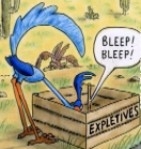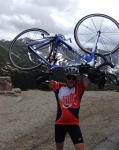A couple of things of note:
When I began, I was given a plain vanilla CPAP, without even a smart card in it, courtesy of my PCP's prescription. (Note that my PCP is totally clueless about sleep apnea.) Two weeks before my first appointment with a sleep doc, said sleep doc ordered a trial period with a recording CPAP so he'd have an idea of what was happening at home when I met with him in mid-December. In comparing my own sleep diary notes to the medical records I received from his office when we parted ways a couple of months ago, a couple of things glaringly pop out at me.
My own diary notes detail how tired I still was every day while using the machine. My first Encore report, with daily details from the second week of December 2007, show a still-high AHI (average of 28) and higher-than-average leak rates every single night. The doctor never mentioned the high leak rates to me, but they should have tipped him off that the other numbers weren't reliable data, and he should have helped me (or sent me back to the DME) to adjust my mask to make my therapy more effective.
My own sleep diary notes from my meeting with the doctor say: "Smart Card reports an AHI of 28, but the doc doesn’t know when they’re occurring; could be happening as I’m falling asleep. Doc prescribed me a machine with C-Flex and a smart card for permanent use so he can see what’s happening whenever I see him, but (the RT at DME) says it’s unlikely my insurance will be okay with that…"
Here's a good example of my daily details during that period. (Look at those really dense clusters and that leak rate! Holy cow.) I was using the Swift II mask back then, and my leak rate should have been around 33 at a pressure of 12.

I know there's limited info on daily detail reports (i.e., no graphs to reveal sleep stages, sleep position, etc.). But when I look at those daily detail reports now, I can see that the events were occurring all through the night, not at the beginning when I was going to sleep, nor immediately after a bathroom break, when I was going back to sleep. I'd told him I fall asleep within 15 minutes of hitting the pillow (there's a notation re: same in his notes), so I don't know why he was so clueless about the fact that I was having OAs all through the night.
The response from the DME isn't surprising now, considering what I've since learned about how this process works and what's really important to the DME (their bottom line, and NOT my successful therapy). If only I'd been more savvy about it all...
In mid-January, about a month later, one of the worker-bees at the DME called and said she'd "pulled a few strings" and got me the machine with the smart card and C-Flex that the doctor prescribed. I thanked her profusely at the time, thinking she'd gone beyond the call of duty on my behalf. (Little did I know.) The new machine was the same basic machine I had originally, but with C-Flex and compliance-only data capability. BFD! That's not what the doctor told me he was prescribing, but that's exactly how the scrip was written ("CPAP Unit: Respironics w/Smart Card & C-Flex to patient comfort"), and that's exactly what I got. The fact that the RT made such a big deal about the insurance probably not covering that scrip is laughable (now). And pffft! to the doctor for lying to me about what he was prescribing. Tell the patient what they want to hear, pat them on the head, and send them on their way.
I can look back now and see just how extremely naive I was to take what the DME and the doctor told me without question. What a dope I was.
I wish I'd kept the sleep diary for a lot longer than I did, but I realized early on that it was of no value to the doctor, so I stopped making the effort to record notes on a daily basis. But I'm glad I have those two months of notes, in any event. Live and learn...












